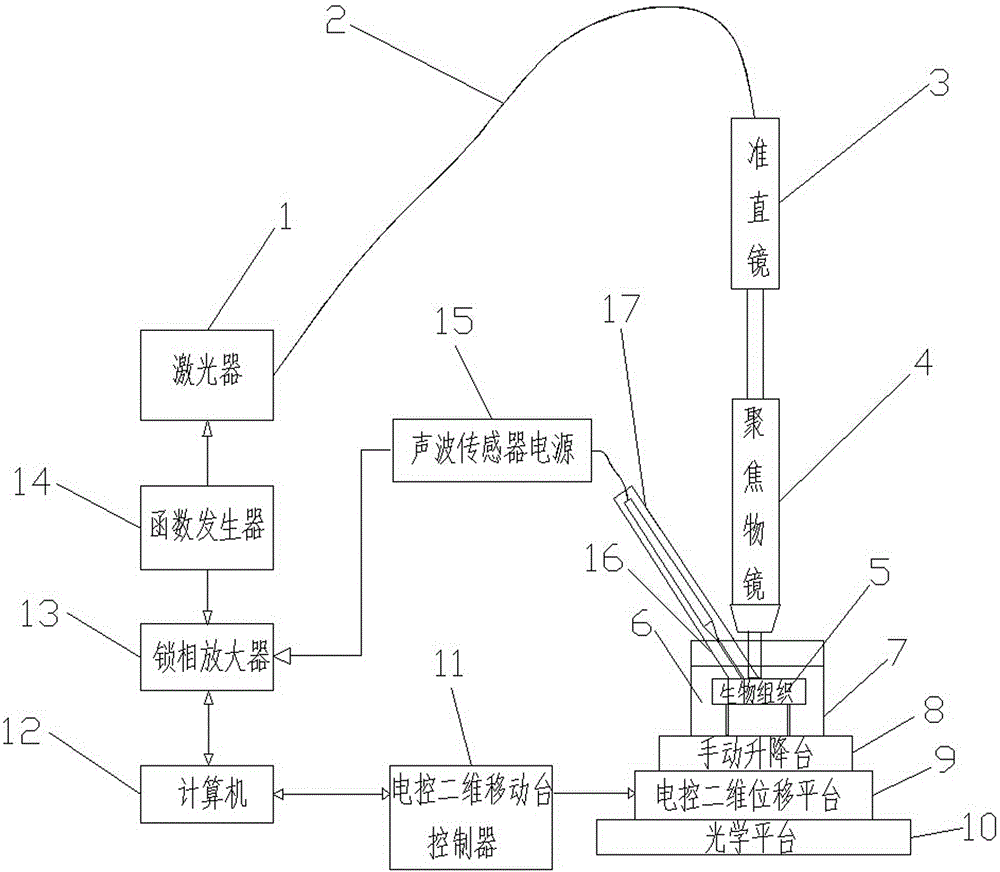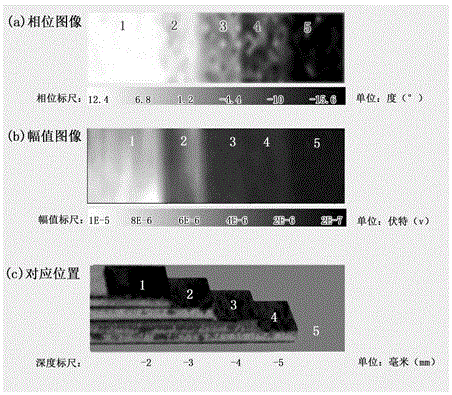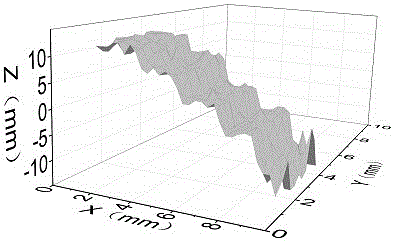Frequency domain photoacoustic imaging detection method and system of biological tissues
A technology for biological tissue and photoacoustic imaging, which is used in measurement devices, material analysis by optical means, instruments, etc. Problems such as large weight and volume, to achieve the effect of high safety, improved signal-to-noise ratio, and high imaging contrast
- Summary
- Abstract
- Description
- Claims
- Application Information
AI Technical Summary
Problems solved by technology
Method used
Image
Examples
specific Embodiment approach 1
[0029] Specific implementation mode one: as figure 1 Shown, a kind of method for biological tissue frequency-domain photoacoustic imaging detection, described method comprises the following steps:
[0030] Step 1: pre-treat the biological tissue 5 to be measured (i.e., remove hair from the biological tissue 5 to be detected, pre-prepared foreign matter treatment) and make a sample, and place the biological tissue sample into the container 7;
[0031] Step 2: add water 6 into the container 7 as the coupling liquid, immerse the biological tissue sample for 5 mm, place the probe of the liquid-coupled acoustic wave sensor 16 into the water 6 in the container 7, pre-condition the probe of the liquid-coupled acoustic wave sensor 16 Infiltration for 25~35min;
[0032] Step 3: start the computer 12, and run the pre-programmed control software in the computer 12;
[0033] Step 4: Adjust the positions of the collimating lens 3 and the focusing objective lens 4, and adjust the manual l...
specific Embodiment approach 2
[0039] Specific implementation mode two: as figure 1 As shown, a system for realizing the frequency-domain photoacoustic imaging detection method of biological tissue according to claim 1, the system includes a laser 1, an optical fiber 2, a collimating mirror 3, a focusing objective lens 4, water 6, a container 7, a manual Lifting platform 8, electronically controlled two-dimensional displacement platform 9, optical platform 10, electronically controlled two-dimensional displacement platform controller 11, computer 12, lock-in amplifier 13, function generator 14, acoustic wave sensor power supply 15, liquid-coupled acoustic wave sensor 16 and its preamplifier 17;
[0040] Water 6 is added into the container 7 as the coupling liquid, the probe of the liquid-coupled acoustic wave sensor 16 is inserted into the water 6 in the container 7, and the power supply 15 of the acoustic wave sensor is respectively supplied to the liquid-coupled acoustic wave sensor 16 and the front Amplif...
Embodiment 1
[0042] A method for frequency-domain photoacoustic imaging detection of biological tissue, the method comprising the following steps:
[0043] Step 1: pre-treat the biological tissue 5 to be measured (i.e., remove hair from the biological tissue 5 to be detected, pre-prepared foreign matter treatment) and make a sample, and place the biological tissue sample into the container 7;
[0044] Step 2: add water 6 into the container 7 as the coupling liquid, immerse the biological tissue sample for 5 mm, place the probe of the liquid-coupled acoustic wave sensor 16 into the water 6 in the container 7, pre-condition the probe of the liquid-coupled acoustic wave sensor 16 Infiltration for 25 minutes;
[0045] Step 3: start the computer 12, and run the pre-programmed control software in the computer 12;
[0046] Step 4: Adjust the positions of the collimating lens 3 and the focusing objective lens 4, and adjust the manual lifting platform 8 so that the focus of the laser spot is locat...
PUM
 Login to View More
Login to View More Abstract
Description
Claims
Application Information
 Login to View More
Login to View More - R&D
- Intellectual Property
- Life Sciences
- Materials
- Tech Scout
- Unparalleled Data Quality
- Higher Quality Content
- 60% Fewer Hallucinations
Browse by: Latest US Patents, China's latest patents, Technical Efficacy Thesaurus, Application Domain, Technology Topic, Popular Technical Reports.
© 2025 PatSnap. All rights reserved.Legal|Privacy policy|Modern Slavery Act Transparency Statement|Sitemap|About US| Contact US: help@patsnap.com



